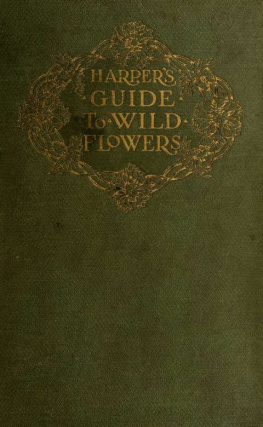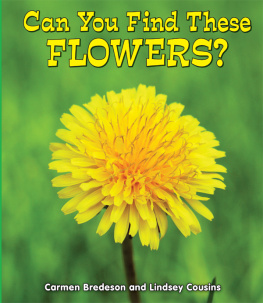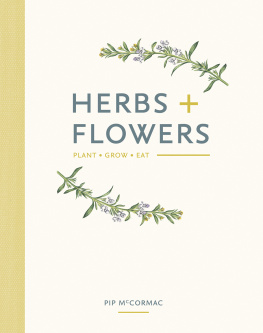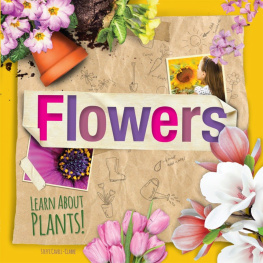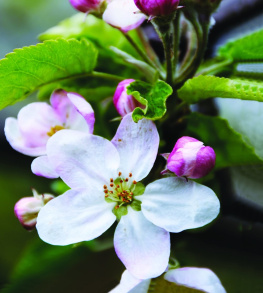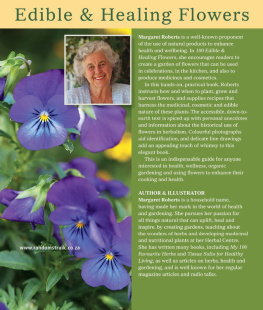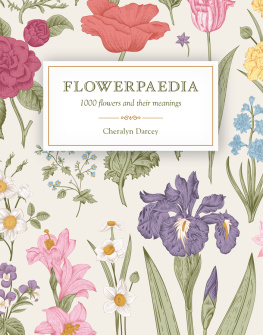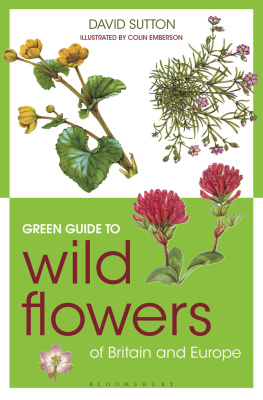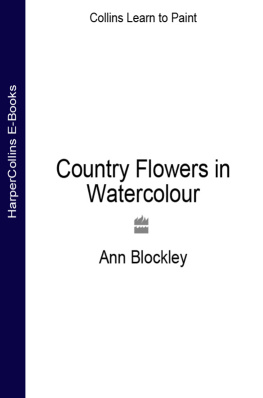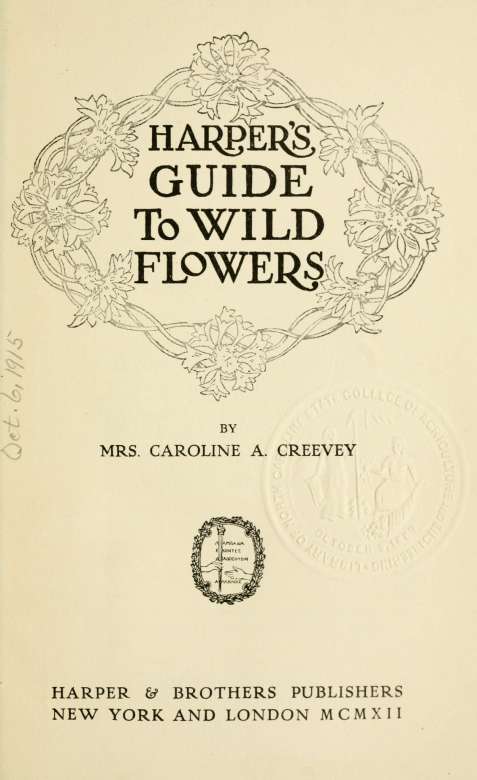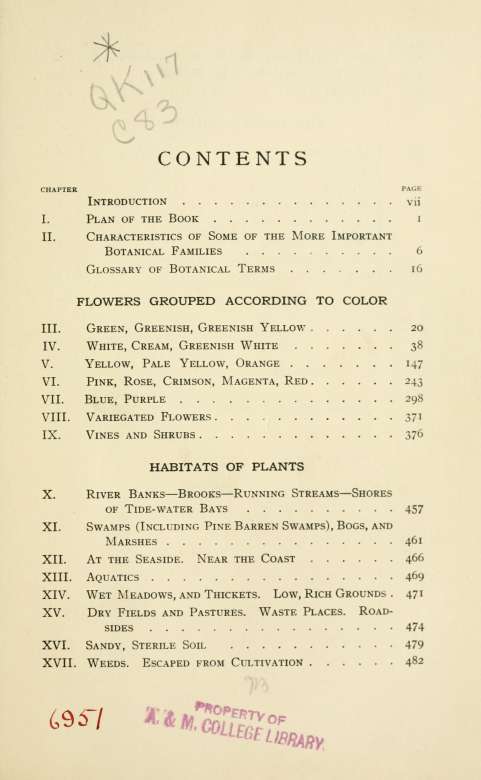This book made available by the Internet Archive.
COLORED PLATES
WILD ROSE. (Rosa canina) Frontispiece
goat's beard. (Tragopogon pratensis) Facing p. 236
FIREWEED. GREAT WILLOW-HERB. (EpiloMum angUSttfo
lium) " 274
true forget-me-not. (Myosotis scorpioides) .... " 328
vervain. (Verbena officinalis) " 330
bluebell, harebell. (Campanula rotundifolia) ... " 352
musk thistle. (Carduus nutans) " 366
bachelor's button, corn-flower. (Centaurea Cyanus)
(Centaurea Jacea) " 368
INTRODUCTION
This book explains the easiest way of telling flowers and plants. These ways are based upon the new classification.
This classification is the one presented in the seventh edition of Gray's Manual of Botany, published in 1908. It embodies the decisions of the Vienna Congress of 1905. The Congress came to an agreement respecting the botanical names and classifications of American flowers, which we hope will not need to be revised. Some old names, dear to us, have come back. Greater simplicity as well as permanency has been aimed for.
The first way of telling flowers is by color. It is the simplest means of identification, and to this the most space is given.
Secondly, flowers may be identified by their dwelling-places or habitats.
Thirdly, flowers are shown by seasons, the time and order of their blossoms.
This book is a Guide to the flowering plants of the Atlantic seaboard, New England, the Middle States, and, to a limited extent, of the Southern States. It is interesting to note the wide latitudinal range of some plants along the entire Atlantic coast. As the climate grows warmer, plants ascend the mountains, and New England vegetation reappears two thousand feet high in Virginia. Plants which are "local," and but seldom found, the size of this book excludes. Plant immigrants, unless well established, are not enumerated.
Taking New York as the center of a wide circle, any person possessing no knowledge of botany (except such as may be acquired from the "Explanation of Technical Terms") may identify any flower and learn something of its story. There is every reason to believe that there is need of a book complete in its means of identification.
HARPER'S GUIDE TO WILD FLOWERS
HARPER'S GUIDE TO WILD FLOWERS
CHAPTER I
PLAN OF THIS BOOK
Few dream of the numbers of flowers which grow all around them. In a short walk one may come across fifty species, and, sitting upon the ground in the woods in summer, one may touch twenty or thirty without moving.
The study of flowers may be called pre-eminently a vacation pursuit, since the summer, our leisure time, is the flowering season. Walking is in danger of becoming a lost art unless some purpose other than healthful exercise is found. Let our little friends of the fields and woods entice us, and their acquaintance, by the help of the Guide, will prove a fascinating pursuit.
It is not only the names of the wild flowers which we all want to know, but the prominent facts connected with their life history. Such facts as the following may be learned:
The red, fuzzy leaves and stems of the sundew are neat little traps for catching small insects upon which this plant varies its normal diet.
The rich colors and strange shapes of orchids and many other flowers are devices for securing the visits of insects which are useful to the flower as pollen-carriers.
Some flowers, in case they fail to secure insect pollination, produce "hidden blossoms" (cletstogamous), which have no beauty of form or color, but which remain closed until after pollination has taken place.
HARPER'S GUIDE TO WILD FLOWERS
Certain plants which cannot bear too great radiation from their leaf - surfaces at night, "sleep," that is, fold their leaflets together. Examine a clover leaf after dark, and look up into a locust-tree by night. The latter looks as if it were hung with strings.
White flowers which cannot attract insects by their bright colors, are apt to be strong-scented.
Many such things, more marvelous than fairy stories, are revealed to us in the study of our common flowers.
Why Do Flowers Have Color?
The organs concerned in the production of seed by which flowering plants are propagated, are the stamens, actively, and pistils, passively.
Stamens produce in their anthers pollen grains, which must be carried to the pistils, either those of the same flower or of another. This process is called pollination. "Cross-pollination," the transference of pollen to a different flower, gives seed greater potency, so that stronger and hardier plants result from it than when the pollen falls upon its own pistil. How is cross-pollination to be obtained? Not by any movements of the flower itself. The aid of some foreign agent must be invoked.
In the evolution of plants, flowers and insects began to appear upon the earth about the same time. At first the colors of all flowers were dull green, greenish white, or white. The food of most insects is nectar, a sweet secretion found in the very heart of flowers, which by them is converted into honey. Insects fly to flowers, dive into them in their efforts to secure the coveted nectar, and, in so doing, necessarily rub their bodies against the upright stamens. If the anthers are ripe and the pollen grains are free, they are caught in their hairy bodies or limbs. The insects then fly to another flower and leave the pollen upon its stigma, provided that is ripe and ready. Many flowers, if neglected by insects, cannot produce seed at all. If the stamens and pistils mature at different times, or if they are so situated that they cannot reach one another, self-pollination cannot take place. Insects must be attracted to such flowers.
That insects are not color-blind may be seen from the fact that they will follow to their undoing "nectar paths,"
PLAN OF THIS BOOK
streaks or lines of color found on the stems of some insect-devouring plants which lead straight to the smooth, fatal rim of the cup.
Evolution of Color in Flowers
Colors of flowers, we may believe, were evolved somewhat in this way: A flower, hitherto white or green, showed by chance a bit of red or yellow, blue or pink, perhaps only a streak or dot. Insects were attracted to that flower, and it was pollinated, while others lacking the color may have been neglected. The tendency of both plants and animals to reproduce marked traits of their parents is well known. The young plant springing from the marked flower would probably reproduce the color rather more strongly, and its offspring more strongly still. In time, perhaps after many generations, a perfectly colored flower would be the result.

